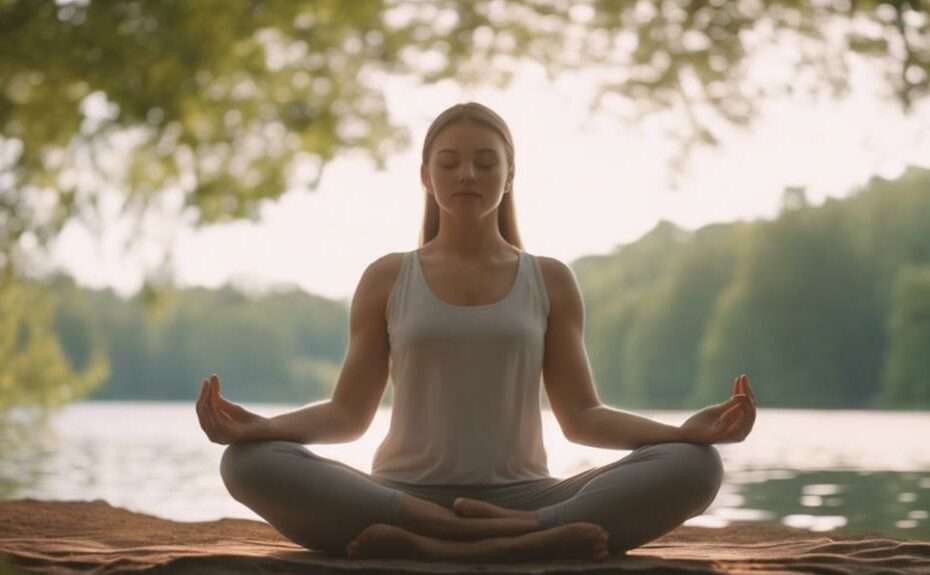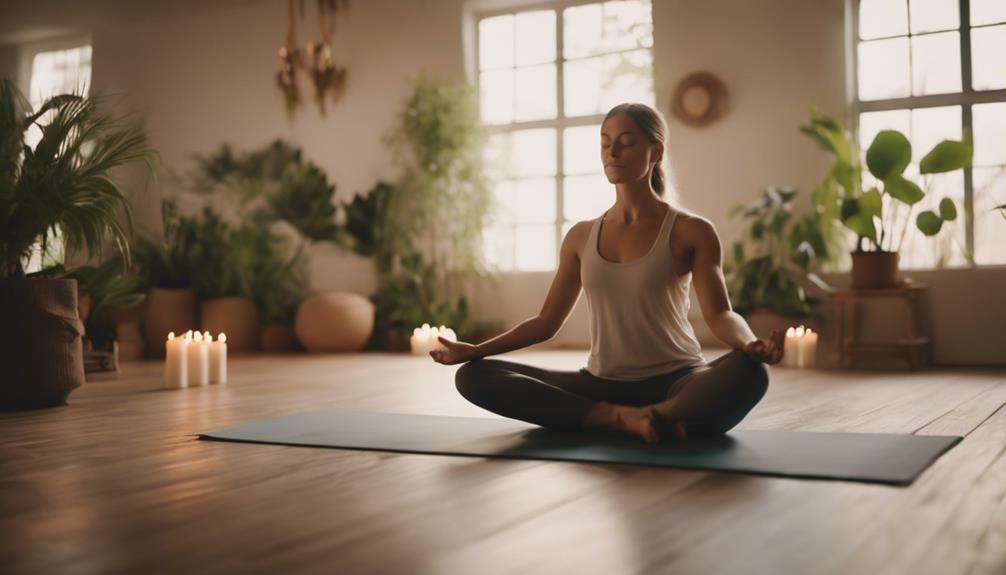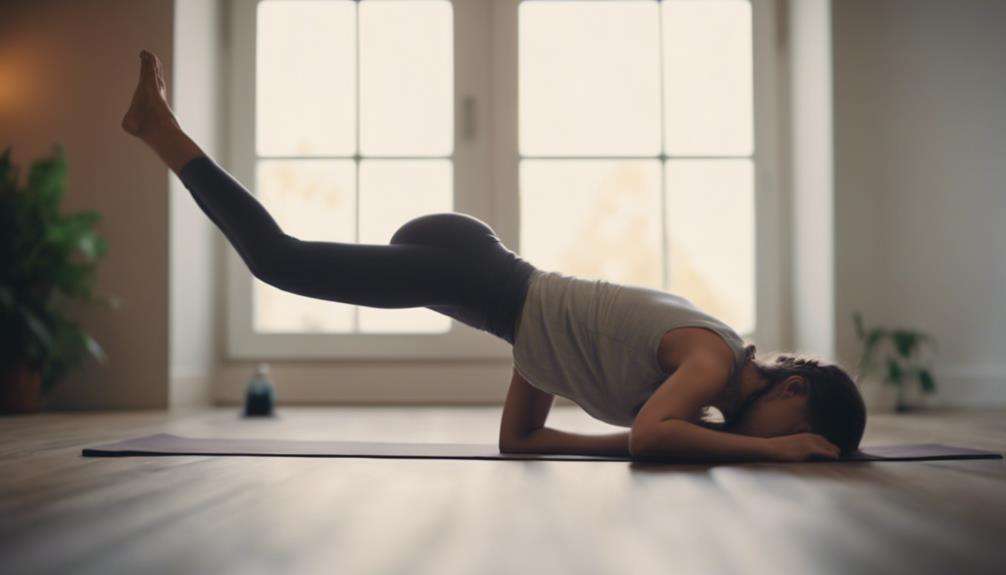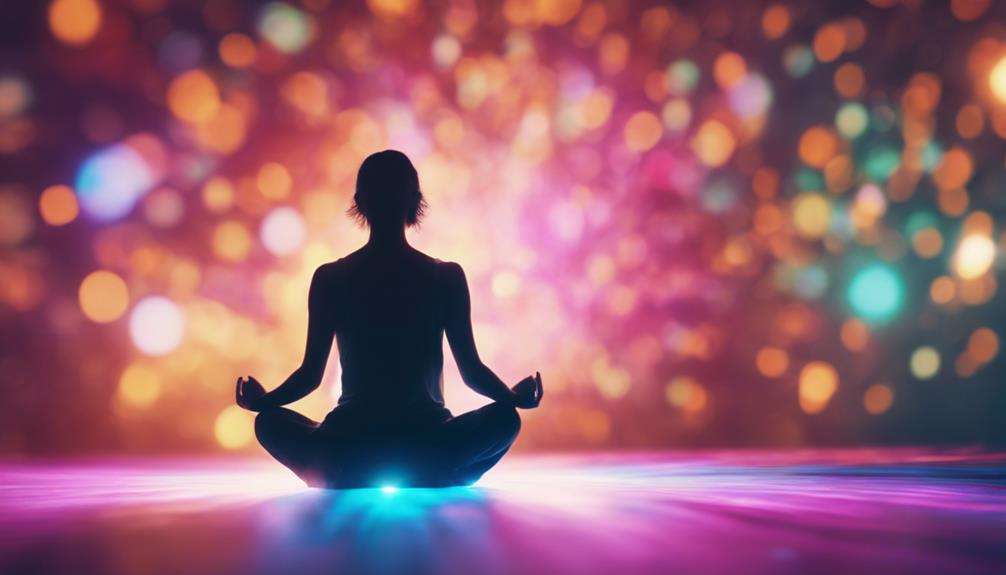Stress can sneak into your life silently, affecting your well-being in various ways. However, have you ever pondered how incorporating yoga and meditation could be the silent solution to this silent intruder?
The blend of movement, breath work, and mental focus in these practices holds the key to a calmer, more balanced existence. But how exactly does this harmonious duo work its magic?
Key Takeaways
- Yoga and meditation reduce stress by promoting inner peace and emotional well-being.
- Mindfulness practices in yoga and meditation enhance relaxation and mental health.
- Breathing techniques in yoga and meditation activate the relaxation response for stress relief.
- Visualization and body scan meditation techniques calm the mind and reduce anxiety effectively.
Benefits of Meditation for Stress Reduction
By incorporating meditation into your daily routine, you can experience a profound reduction in stress levels and a newfound sense of inner peace and balance. Meditation is a powerful tool that can help you find calmness amidst the chaos of daily life. Through practices like guided meditation, where a trained practitioner leads you through a calming mental exercise, or mantra meditation, where you repeat a word or phrase to focus your mind, you can effectively reduce stress and anxiety symptoms.
Embracing meditation not only provides stress relief benefits but also contributes to your emotional well-being. It allows you to cultivate a sense of tranquility and mindfulness that can help you navigate through life's challenges with more ease. Regular meditation practice has been shown to enhance overall mental health, promoting a state of inner peace that radiates into every aspect of your life. So, take a few moments each day to sit quietly, focus on your breath, and let meditation guide you towards a more balanced and stress-free existence.
Mindfulness Practices for Relaxation
To enhance your relaxation and inner peace, incorporating mindfulness practices in yoga and meditation can be incredibly beneficial. Mindfulness practices involve directing calm observant attention to your thoughts and sensations, allowing you to acknowledge them without judgment. By doing so, you can reduce anxiety symptoms and enter a meditative state that aids in stress reduction.
In yoga, these practices are combined with specific poses that address muscle tension and promote relaxation. Stretching in yoga helps release tension in the body, alleviating stress-related muscle soreness. For example, poses like childs pose and cat-cow pose target areas of tightness, facilitating tension release and deep relaxation.
Integrating mindfulness into your yoga and meditation routines not only benefits your physical well-being but also nurtures your mental and emotional health, providing you with a holistic approach to managing stress and finding tranquility.
Deep Breathing Techniques for Stress Relief
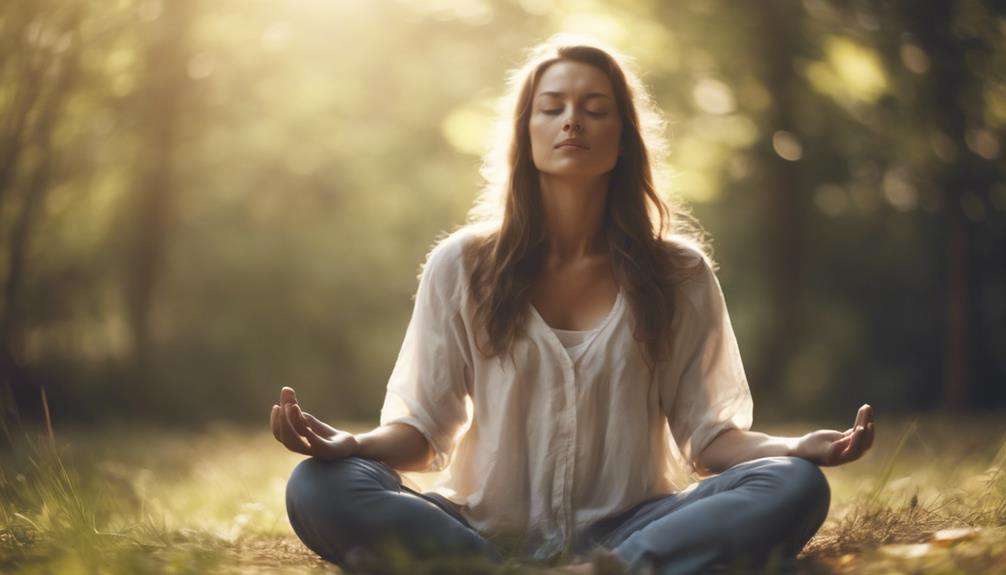
Are you ready to discover the transformative power of deep breathing techniques for stress relief?
By engaging in intentional breathwork, you can tap into a natural mechanism that calms your mind and body, paving the way for relaxation.
Let's explore the benefits of deep breathing, learn effective techniques for soothing your nerves, and unlock the path to stress relief through the simple act of breathing.
Benefits of Deep Breathing
Unlock the power of deep breathing techniques for stress relief by incorporating simple yet effective practices into your daily routine. Deep breathing offers a myriad of benefits that contribute to your overall well-being.
Here are some advantages of deep breathing:
- Activates the relaxation response, reducing stress and anxiety levels.
- Regulates the autonomic nervous system, promoting calmness and mental clarity.
- Enhances oxygen flow to the brain, improving focus and cognitive function.
- Lowers blood pressure, heart rate, and cortisol levels, key indicators of stress.
Techniques for Relaxation
Discover effective deep breathing techniques that can help you alleviate stress and promote relaxation in your daily life.
In yoga, deep breathing activates the relaxation response, reducing cortisol levels and calming the nervous system.
By taking slow, deep breaths, you increase oxygen supply to your brain, lowering heart rate, blood pressure, and perceived stress levels.
Regular practice of deep breathing not only improves lung function but also fosters a sense of calm and well-being.
Integrating deep breathing into your daily routine can effectively manage stress, anxiety, and enhance mental and emotional balance.
Embrace these techniques to cultivate a peaceful state of mind and body, empowering yourself to navigate life's challenges with resilience and serenity.
Stress Relief Through Breath
As you seek to find moments of peace amidst life's demands, practicing deep breathing techniques offers a powerful gateway to alleviate stress and cultivate inner calmness.
Deep breathing in yoga helps trigger the body's relaxation response, decreasing stress hormones and promoting calmness. Research indicates that deep breathing can lower heart rate and blood pressure, contributing to a sense of tranquility.
Regular practice of deep breathing enhances oxygen flow, aiding in relaxation and stress reduction. Techniques like diaphragmatic breathing improve focus and mental clarity, reducing anxiety.
Incorporate mindful deep breathing exercises into your daily routine for immediate stress relief and a refreshed perspective on managing life's challenges.
Visualization Exercises for Calming the Mind
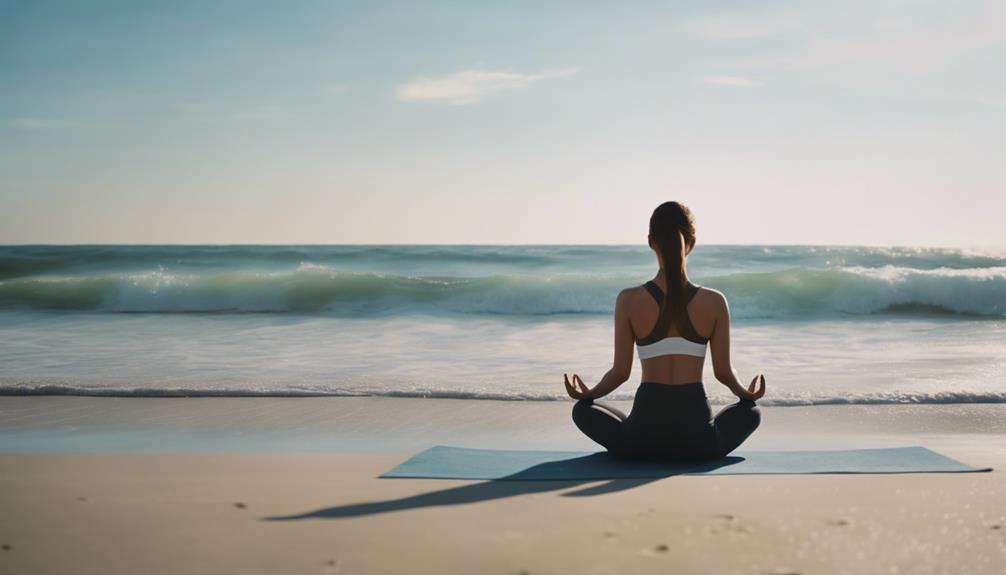
Enhance your mental well-being and reduce stress through the practice of visualization exercises, where you imagine peaceful scenes or positive outcomes to calm your mind. By engaging in visualization techniques, you can effectively reduce stress and anxiety by redirecting your focus towards soothing mental images. Studies have demonstrated that these exercises play a significant role in lowering cortisol levels, the hormone associated with stress. Regular practice of visualization can't only lower stress levels but also improve your mood, promote relaxation, and contribute to an overall sense of well-being.
Incorporating visualization into your meditation or yoga routines can enhance your stress relief efforts and boost mental clarity. The power of visualization lies in its ability to transport you to a tranquil mental space, allowing you to escape the pressures of daily life momentarily. So, take a moment to visualize serenity and positivity, and let these mental images guide you towards a calmer, more relaxed state of mind.
Body Scan Meditation for Relaxation
Are you ready to discover the soothing power of body scan meditation?
This practice involves focusing on each part of your body, helping you cultivate a deeper mind-body connection and melting away stress.
Benefits of Body Scanning
To experience deep relaxation and promote mindfulness, engaging in body scan meditation can be incredibly beneficial. Here are some reasons why body scanning is advantageous:
- Enhances awareness of your body and its sensations.
- Facilitates relaxation and reduces stress levels effectively.
- Helps in cultivating mindfulness and being present in the moment.
- Releases muscle tension, promoting overall well-being.
Mind-Body Connection Practice
Immerse yourself in the practice of body scan meditation to nurture a harmonious connection between your mind and body, fostering deep relaxation and mindfulness.
Body scan meditation involves systematically focusing on each body part, enhancing body awareness and reducing physical tension. By scanning from head to toe, you promote mindfulness and cultivate inner peace.
This practice can be done seated or lying down, making it accessible for all. Through body scan meditation, you release stress stored in your body, allowing for a deep sense of relaxation.
Embracing this mind-body connection technique offers a powerful tool for stress relief and overall well-being. Prioritize moments for body scan meditation in your routine to experience the transformative benefits it brings to your daily life.
Stress Relief Technique
Nurturing your mind-body connection through body scan meditation is a powerful way to release tension and promote deep relaxation, offering a valuable technique for combating stress.
Here's why body scan meditation is a beneficial stress relief technique:
- Body scan meditation involves systematically focusing on each body part to release tension and promote relaxation.
- It increases body awareness and reduces both physical and mental stress by mindfully scanning sensations.
- By starting from the head and moving down to the toes, body scan meditation addresses areas of tension and promotes relaxation.
- Research indicates that this practice can decrease cortisol levels, the stress hormone, leading to a calmer state of mind. Regular practice can enhance the relaxation response, improve sleep quality, and reduce symptoms of anxiety and stress.
Progressive Muscle Relaxation for Stress Reduction
Engaging in Progressive Muscle Relaxation is a powerful technique for reducing stress and promoting relaxation. By systematically tensing and relaxing different muscle groups, PMR helps you identify and release tension throughout your body. This practice enhances body awareness, allowing you to pinpoint areas of physical stress and effectively alleviate them.
Research indicates that PMR not only lowers anxiety levels but also contributes to an overall improvement in well-being. Regularly incorporating PMR into your routine can equip you with valuable stress management skills and cultivate relaxation responses. The deliberate focus on relaxing muscle groups can have a profound impact on your ability to unwind and combat the effects of stress.
Guided Imagery for Mental Peace
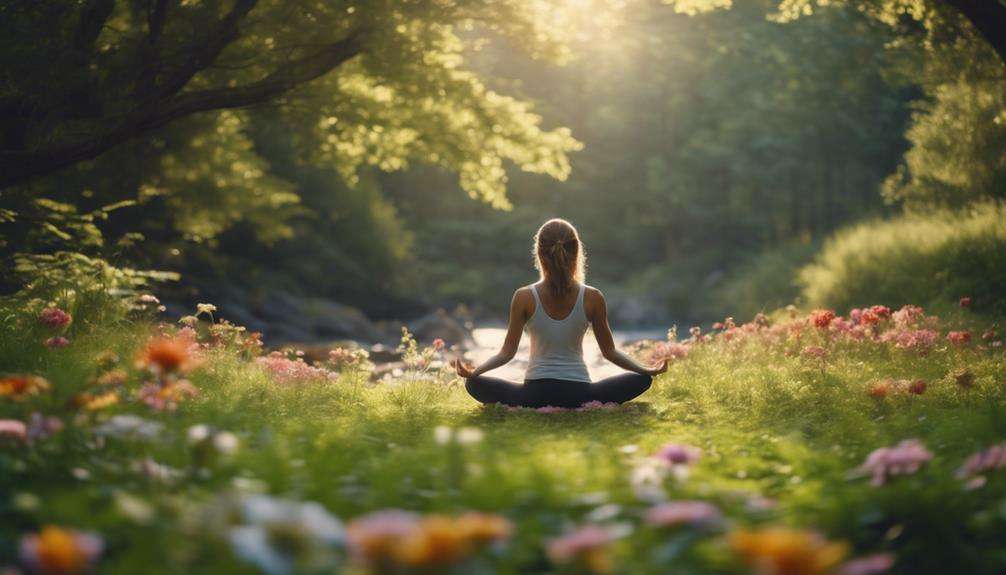
Discover how incorporating guided imagery into your daily routine can bring about mental peace and reduce stress levels effectively. Guided imagery is a powerful relaxation technique that leverages visualizations to create a sense of calm and tranquility within you. Here are four key benefits of incorporating guided imagery into your stress reduction practices:
- Reduction in Cortisol Levels: Guided imagery has been shown to lower cortisol levels, the hormone associated with stress, thereby promoting a more relaxed state of being.
- Anxiety Management: By engaging in guided imagery sessions, you can effectively manage feelings of anxiety and cultivate a sense of inner peace.
- Enhanced Emotional Well-being: This technique can help improve your emotional well-being by fostering positive thoughts and emotions through visualization exercises.
- Holistic Approach to Stress Reduction: When combined with practices like meditation and yoga, guided imagery offers a holistic approach to reducing stress and enhancing overall mental health.
Embrace guided imagery as a tool to nurture your mind and soul, paving the way for a more peaceful existence.
Frequently Asked Questions
How Does Meditation and Yoga Reduce Stress?
When you meditate and practice yoga, you calm your mind and body, activate the relaxation response, regulate stress hormones, use breathing techniques, foster mindfulness, nurture a calm mind, enhance emotional regulation, build neural pathways, and develop self-awareness.
Why Does Meditation Decrease Stress?
When meditation decreases stress, it balances your mind-body connection. It regulates stress hormones, rewires neural pathways, triggers the relaxation response, enhances emotional regulation, sharpens cognitive function, fosters mindfulness, reduces anxiety, and boosts self-awareness.
What Is the Role of Yoga and Meditation in Coping With Emotions?
In coping with emotions, yoga and meditation play vital roles. They enhance emotional regulation, stress management, and promote self-awareness. By fostering a mind-body connection, these practices empower you to navigate emotions with skill and resilience.
What Are the Mental Benefits of Yoga and Meditation?
Enhanced focus, improved mood, decreased anxiety, boosted resilience, enhanced self-awareness, increased relaxation, enhanced mental clarity, improved emotional regulation, and increased mindfulness are all mental benefits of yoga and meditation that contribute to your overall well-being and growth.
Conclusion
You've discovered the key to unlocking a stress-free life: yoga and meditation. By incorporating these practices into your daily routine, you can experience a newfound sense of inner peace and calm.
Through mindfulness, deep breathing, visualization, body scan, progressive muscle relaxation, and guided imagery, you have the power to reduce stress levels and cultivate a harmonious mind-body connection.
Embrace these tools, and watch as your stress melts away, leaving you feeling balanced, focused, and truly at peace.
